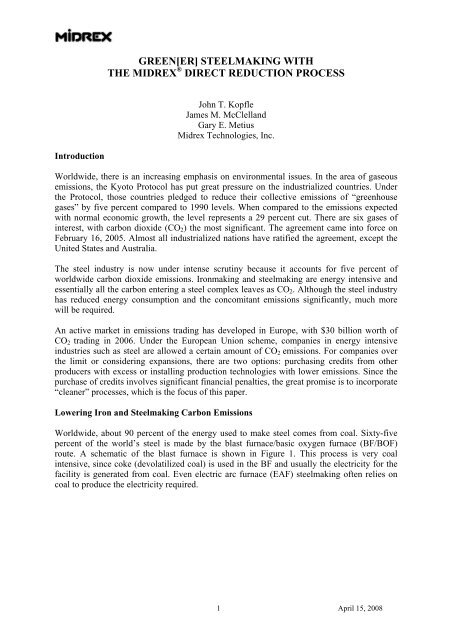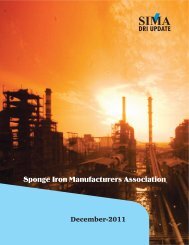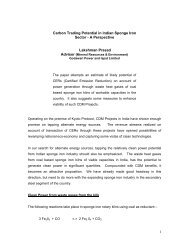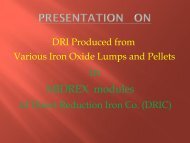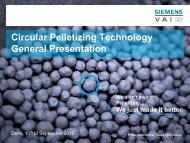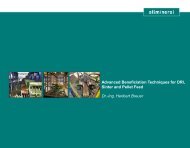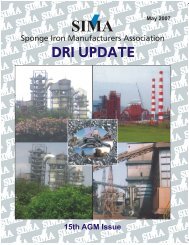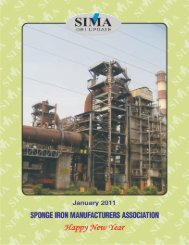Green Steelmaking with the MIDREX and FASTMET Processes
Green Steelmaking with the MIDREX and FASTMET Processes
Green Steelmaking with the MIDREX and FASTMET Processes
You also want an ePaper? Increase the reach of your titles
YUMPU automatically turns print PDFs into web optimized ePapers that Google loves.
GREEN[ER] STEELMAKING WITH<br />
THE <strong>MIDREX</strong> ® DIRECT REDUCTION PROCESS<br />
John T. Kopfle<br />
James M. McClell<strong>and</strong><br />
Gary E. Metius<br />
Midrex Technologies, Inc.<br />
Introduction<br />
Worldwide, <strong>the</strong>re is an increasing emphasis on environmental issues. In <strong>the</strong> area of gaseous<br />
emissions, <strong>the</strong> Kyoto Protocol has put great pressure on <strong>the</strong> industrialized countries. Under<br />
<strong>the</strong> Protocol, those countries pledged to reduce <strong>the</strong>ir collective emissions of “greenhouse<br />
gases” by five percent compared to 1990 levels. When compared to <strong>the</strong> emissions expected<br />
<strong>with</strong> normal economic growth, <strong>the</strong> level represents a 29 percent cut. There are six gases of<br />
interest, <strong>with</strong> carbon dioxide (CO 2 ) <strong>the</strong> most significant. The agreement came into force on<br />
February 16, 2005. Almost all industrialized nations have ratified <strong>the</strong> agreement, except <strong>the</strong><br />
United States <strong>and</strong> Australia.<br />
The steel industry is now under intense scrutiny because it accounts for five percent of<br />
worldwide carbon dioxide emissions. Ironmaking <strong>and</strong> steelmaking are energy intensive <strong>and</strong><br />
essentially all <strong>the</strong> carbon entering a steel complex leaves as CO 2 . Although <strong>the</strong> steel industry<br />
has reduced energy consumption <strong>and</strong> <strong>the</strong> concomitant emissions significantly, much more<br />
will be required.<br />
An active market in emissions trading has developed in Europe, <strong>with</strong> $30 billion worth of<br />
CO 2 trading in 2006. Under <strong>the</strong> European Union scheme, companies in energy intensive<br />
industries such as steel are allowed a certain amount of CO 2 emissions. For companies over<br />
<strong>the</strong> limit or considering expansions, <strong>the</strong>re are two options: purchasing credits from o<strong>the</strong>r<br />
producers <strong>with</strong> excess or installing production technologies <strong>with</strong> lower emissions. Since <strong>the</strong><br />
purchase of credits involves significant financial penalties, <strong>the</strong> great promise is to incorporate<br />
“cleaner” processes, which is <strong>the</strong> focus of this paper.<br />
Lowering Iron <strong>and</strong> <strong>Steelmaking</strong> Carbon Emissions<br />
Worldwide, about 90 percent of <strong>the</strong> energy used to make steel comes from coal. Sixty-five<br />
percent of <strong>the</strong> world’s steel is made by <strong>the</strong> blast furnace/basic oxygen furnace (BF/BOF)<br />
route. A schematic of <strong>the</strong> blast furnace is shown in Figure 1. This process is very coal<br />
intensive, since coke (devolatilized coal) is used in <strong>the</strong> BF <strong>and</strong> usually <strong>the</strong> electricity for <strong>the</strong><br />
facility is generated from coal. Even electric arc furnace (EAF) steelmaking often relies on<br />
coal to produce <strong>the</strong> electricity required.<br />
1 April 15, 2008
Figure 1<br />
Blast Furnace<br />
Source: www.bbc.co.uk<br />
On a macro basis, <strong>the</strong>re are three ways to lower CO 2 emissions from iron <strong>and</strong> steelmaking<br />
production: 1) reduce energy consumption so that less energy (<strong>and</strong> carbon) is required per ton<br />
of steel produced, 2) sequester <strong>the</strong> CO 2 produced underground, ei<strong>the</strong>r in storage or for<br />
enhanced oil recovery, <strong>and</strong> 3) use an energy source <strong>with</strong> less carbon than coal. Option 1) has<br />
been a serious focus for many years. Since 1980, <strong>the</strong> USA steel industry has reduced energy<br />
consumption per ton of steel 45 percent. However, fur<strong>the</strong>r gains are increasingly difficult as<br />
<strong>the</strong> processes become more <strong>and</strong> more efficient. Option 2) is being studied <strong>and</strong> <strong>the</strong>re is<br />
promise, but it does nothing to reduce emissions from <strong>the</strong> iron <strong>and</strong> steelmaking processes, it<br />
just reduces <strong>the</strong> CO 2 emitted to <strong>the</strong> atmosphere. Also, <strong>the</strong>re are significant practical<br />
limitations that must be overcome for this approach to have a major impact. Option 3) may<br />
hold <strong>the</strong> most promise for significantly reducing carbon emissions. An attractive energy<br />
source is natural gas.<br />
Natural gas is primarily methane, <strong>with</strong> a chemical formula of CH 4 . Thus, <strong>the</strong>re are four<br />
hydrogen atoms for each carbon atom. Coal is a diverse mixture of compounds, but it has a<br />
higher proportion of carbon to hydrogen than does natural gas. Since almost all <strong>the</strong> carbon<br />
<strong>and</strong> hydrogen used in an iron <strong>and</strong> steelmaking facility are eventually converted to CO 2 <strong>and</strong><br />
H 2 O (water), natural gas produces much less carbon dioxide than does coal. Table I shows<br />
<strong>the</strong> CO 2 emission rates for combusting methane versus two types of coal.<br />
2 April 15, 2008
TABLE I<br />
CO 2 EMISSIONS FOR IRON AND<br />
STEELMAKING ENERGY SOURCES<br />
CO 2 Emissions<br />
Energy Source (t/TJ) (lbs/MMBtu)<br />
Natural gas (CH 4 ) 49 115<br />
Bituminous metallurgical coal 90 212<br />
Bituminous steam coal 94 220<br />
As <strong>the</strong> table shows, natural gas emits only about one-half <strong>the</strong> CO 2 per unit of energy as does<br />
coal. This characteristic makes natural gas an ideal energy source for steelmaking. One<br />
proven method for producing steel using natural gas is <strong>the</strong> shaft furnace direct reduction (DR)<br />
plus EAF steelmaking route. In this case, natural gas is used in a direct reduction technology<br />
such as <strong>the</strong> <strong>MIDREX</strong> ® Process as a reductant to remove oxygen from iron <strong>and</strong> as a fuel to<br />
provide heat. Natural gas can also be used to produce <strong>the</strong> electricity required for <strong>the</strong> EAF.<br />
The DR/EAF combination has much lower carbon emissions per ton of steel than does <strong>the</strong><br />
BF/BOF process.<br />
Get It While It’s Hot<br />
In <strong>the</strong> DR/EAF route, carbon emissions can be fur<strong>the</strong>r reduced by hot charging <strong>the</strong> DRI to <strong>the</strong><br />
EAF. Traditionally, almost all <strong>MIDREX</strong> ® Plants <strong>with</strong> an adjacent meltshop have cooled <strong>the</strong><br />
DRI <strong>and</strong> stored it for later charging to <strong>the</strong> EAF. Now, Midrex has developed three methods<br />
for discharging <strong>the</strong> DRI at elevated temperature, transporting it hot to <strong>the</strong> meltshop, <strong>and</strong><br />
charging it to <strong>the</strong> EAF at 600-700º C (see Figure 2). These methods lower <strong>the</strong> electricity<br />
required per ton of steel produced, which also reduces CO 2 emissions from <strong>the</strong> power plant.<br />
The electricity savings occur because less energy is required in <strong>the</strong> EAF to heat <strong>the</strong> DRI to<br />
melting temperature. The rule-of-thumb is that electricity consumption can be reduced about<br />
20 kWh/t liquid steel for each 100º C increase in DRI charging temperature. Thus, <strong>the</strong><br />
savings when charging at over 600º C are 120 kWh/t or more. With <strong>the</strong> use of hot charging,<br />
<strong>the</strong> DR/EAF route becomes even more attractive.<br />
3 April 15, 2008
Figure 2<br />
Hot Discharge/Transport/Charging Options<br />
Show Me <strong>the</strong> Numbers<br />
To highlight <strong>the</strong> significant emissions advantage of <strong>the</strong> DR/EAF steelmaking route versus <strong>the</strong><br />
BF/BOF route, Midrex performed a detailed analysis of various steelmaking methods,<br />
including <strong>the</strong> blast furnace/BOF <strong>and</strong> <strong>the</strong> EAF fed <strong>with</strong> various mixes of scrap plus alternate<br />
iron (DRI, HBI, <strong>and</strong> pig iron). The EAF options included 80% cold DRI/20% scrap, 80% hot<br />
DRI/20% scrap, 30% cold DRI/70% scrap, 30% HBI/70% scrap, 30% pig iron/70% scrap,<br />
<strong>and</strong> 100% scrap.<br />
The calculations determined <strong>the</strong> energy requirements <strong>and</strong> CO 2 emissions for <strong>the</strong> entire<br />
processes, from iron ore <strong>and</strong> coke preparation through <strong>the</strong> production of liquid steel. Midrex<br />
originally performed <strong>the</strong>se calculations in 2001, <strong>and</strong> details of <strong>the</strong> procedure are given in<br />
reference 1. For this paper, <strong>the</strong> HDRI case was added. The results are shown in Figure 3 <strong>and</strong><br />
are presented per ton of liquid steel produced.<br />
4 April 15, 2008
GJ/t LS (Total energy)<br />
20.0<br />
18.0<br />
16.0<br />
14.0<br />
12.0<br />
10.0<br />
8.0<br />
6.0<br />
4.0<br />
2.0<br />
0.0<br />
16.8<br />
1959<br />
18.1<br />
1140<br />
16.6<br />
1033<br />
10.6<br />
713<br />
Total energy<br />
Carbon emissions<br />
11.6<br />
784<br />
10.8<br />
1175<br />
6.2<br />
466<br />
2500<br />
2000<br />
1500<br />
1000<br />
500<br />
0<br />
kg CO 2 /t LS (Carbon emissions)<br />
BF-BOF<br />
80% Cold DRI<br />
80% Hot DRI<br />
30% Cold DRI<br />
30% HBI<br />
30% PIG IRON<br />
100% SCRAP<br />
Figure 3<br />
Energy Requirements <strong>and</strong> Carbon Emissions<br />
for <strong>Steelmaking</strong> Routes<br />
As <strong>the</strong> graph shows, <strong>the</strong> lowest energy requirement <strong>and</strong> carbon emissions result from <strong>the</strong> use<br />
of 100 percent scrap steel in an EAF. This occurs because scrap is a valuable “natural<br />
resource” that should be used when possible. All <strong>the</strong> energy used to produce that steel has<br />
been spent, <strong>and</strong> thus <strong>the</strong> energy required to recycle it is low, as are <strong>the</strong> carbon emissions.<br />
However, <strong>the</strong>re is a limit to <strong>the</strong> amount of scrap that can be collected <strong>and</strong> used, so it is<br />
necessary to process iron ore to satisfy <strong>the</strong> world’s steel needs. Also, it is often not possible<br />
to produce “clean” steels <strong>with</strong> good processing characteristics from many grades of scrap,<br />
<strong>and</strong> a source of nearly pure iron is required. Thus, process technologies using iron ore, such<br />
as <strong>the</strong> BF/BOF <strong>and</strong> DR/EAF combinations, are necessary.<br />
The DR/EAF route using 80 percent DRI <strong>and</strong> 20 percent scrap, which is a typical ratio in<br />
natural gas-rich areas, has significantly lower carbon emissions than does <strong>the</strong> BF/BOF<br />
method. If <strong>the</strong> DRI is allowed to cool <strong>and</strong> <strong>the</strong>n charged to <strong>the</strong> EAF (CDRI), <strong>the</strong> emissions are<br />
42 percent less. The use of hot DRI (HDRI) provides even greater savings of 47 percent.<br />
In <strong>the</strong> case of a steel mill <strong>with</strong>out a captive DR plant, <strong>the</strong> use of 70 percent scrap plus 30<br />
percent alternate iron enables it to produce clean steel. Carbon emissions in those cases are<br />
much lower than for <strong>the</strong> BF/BOF option.<br />
For <strong>the</strong> process routes using a high percentage of iron, <strong>the</strong> total energy requirements are<br />
about <strong>the</strong> same, because <strong>the</strong> BF/BOF <strong>and</strong> 80% DRI/EAF cases are both energy efficient.<br />
5 April 15, 2008
The <strong>Green</strong> Solution<br />
Regions such as <strong>the</strong> Middle East, South America, <strong>and</strong> Russia have already discovered <strong>the</strong><br />
benefits of <strong>the</strong> natural gas-based DR/EAF steelmaking route. In 2006, world DRI production<br />
was about 60 million tons. Because of <strong>the</strong> flexibility <strong>and</strong> attractive economics in areas <strong>with</strong><br />
abundant, low cost gas, much more capacity is on <strong>the</strong> way. Table II shows <strong>MIDREX</strong> Plants<br />
recently started up <strong>and</strong> those under construction. Midrex expects to sign additional contracts<br />
in 2007.<br />
Table II<br />
NEW <strong>MIDREX</strong> PROJECTS<br />
PLANT Country Start-Up Capacity (tpy) Product<br />
Essar Module V India 2006 1,500,000 Hot DRI & HBI<br />
Nu-Iron Trinidad 2006 1,600,000 Cold DRI<br />
Acindar Expansion Argentina 2007 250,000 Cold DRI<br />
Al-Tuwairqi Saudi Arabia 2007 1,000,000 Cold DRI<br />
Hadeed Mod E Saudi Arabia 2007 1,760,000 Hot & Cold DRI<br />
LGOK Module 2 Russia 2007 1,400,000 HBI<br />
Qatar Steel Co. Module 2 Qatar 2007 1,500,000 Cold DRI & HBI<br />
Lion Group Malaysia 2008 1,540,000 Hot DRI & HBI<br />
Shadeed Oman 2008 1,500,000 HOTLINK & HBI<br />
Tuwairqi Steel Mills Pakistan 2008 1,280,000 Hot & Cold DRI<br />
ESISCO Egypt 2009 1,760,000 Hot & Cold DRI<br />
TOTAL 15,090,000<br />
With increasing focus on carbon emissions, <strong>the</strong>re is now a compelling environmental reason<br />
to choose <strong>the</strong> natural gas-based DR/EAF route. A recent report prepared for Environment<br />
Canada noted <strong>the</strong> environmental benefits of <strong>the</strong> <strong>MIDREX</strong> Process:<br />
“DRI plants using natural gas as <strong>the</strong> reduction material have lower CO 2 emissions<br />
than coal based plants… It was estimated that <strong>the</strong> BAT plant [<strong>MIDREX</strong> Plant] would<br />
emit 24 percent less CO 2 <strong>and</strong> at least 24 percent less TPM, NOx, SOx, <strong>and</strong> VOCs than<br />
a conventional integrated [BF/BOF] plant.” (2)<br />
As steel companies become increasingly globalized, <strong>the</strong>y will have many opportunities to<br />
incorporate this technology option into <strong>the</strong>ir CO 2 management plan by installing direct<br />
reduction plants in regions <strong>with</strong> low cost gas. It should even be possible to apply <strong>the</strong> carbon<br />
credits generated in those facilities to carbon restricted regions such as Europe <strong>and</strong> North<br />
America.<br />
Thinking Outside <strong>the</strong> Box<br />
Midrex continues to be proactive in reducing <strong>the</strong> environmental impact of its ironmaking<br />
processes <strong>and</strong> associated steelmaking technologies. There are several ways to reduce carbon<br />
emissions to lower levels than shown in Figure 3. If <strong>the</strong> electricity required for <strong>the</strong> <strong>MIDREX</strong><br />
Process <strong>and</strong> for <strong>the</strong> EAF is generated by a non-hydrocarbon source, this would cut emissions<br />
even fur<strong>the</strong>r. Possibilities are power generated from nuclear, solar, wind, <strong>and</strong> hydro sources.<br />
It is even possible to build a <strong>MIDREX</strong> Plant <strong>with</strong> zero carbon emissions to <strong>the</strong> atmosphere.<br />
An amine type or PSA CO 2 removal system would strip CO 2 from <strong>the</strong> flue gas to create a<br />
high purity stream. That stream could be injected underground for enhanced oil recovery or<br />
6 April 15, 2008
sequestration. Use for enhanced oil recovery is an excellent approach. Many producers are<br />
now injecting CO 2 or steam in old oil fields, which can increase production two to three-fold.<br />
This should be a good possibility for <strong>MIDREX</strong> Plants, since <strong>the</strong>y are located in gas-rich areas<br />
which often have oil as well.<br />
Conclusions<br />
The increasing emphasis on <strong>the</strong> environment creates a need for innovative solutions to reduce<br />
carbon emissions from iron <strong>and</strong> steelmaking facilities. One good approach is to use natural<br />
gas as a reductant <strong>and</strong> fuel source, since it results in far less CO 2 emissions than coal. A<br />
proven method is natural gas-based direct reduction, such as <strong>the</strong> <strong>MIDREX</strong> ® Process, paired<br />
<strong>with</strong> an electric arc furnace. Use of 80 percent hot charged DRI in <strong>the</strong> EAF results in 47<br />
percent lower carbon emissions per ton of steel produced than <strong>the</strong> blast furnace/BOF route.<br />
Many regions <strong>with</strong> abundant natural gas have seen major growth in DRI production <strong>and</strong> <strong>the</strong>re<br />
is over 14 million tons of new <strong>MIDREX</strong> Plant capacity recently started up or under<br />
construction in <strong>the</strong> Middle East, Latin America, Asia, <strong>and</strong> Russia. Several approaches hold<br />
<strong>the</strong> possibility of reducing carbon emission even fur<strong>the</strong>r.<br />
References<br />
1. McClell<strong>and</strong>, James, Sara Hornby Anderson, <strong>and</strong> Gary Metius: “Future <strong>Green</strong><br />
<strong>Steelmaking</strong>,” presented to SEAISI 2002 Conference, Tokyo, Japan, April 2002<br />
2. Multi-pollutant Emission Reduction Analysis Foundation (MERAF) for <strong>the</strong> Iron <strong>and</strong> Steel<br />
Sector, Charles E. Napier Co. Ltd, Canada, September 11, 2002, p. xviii<br />
7 April 15, 2008


